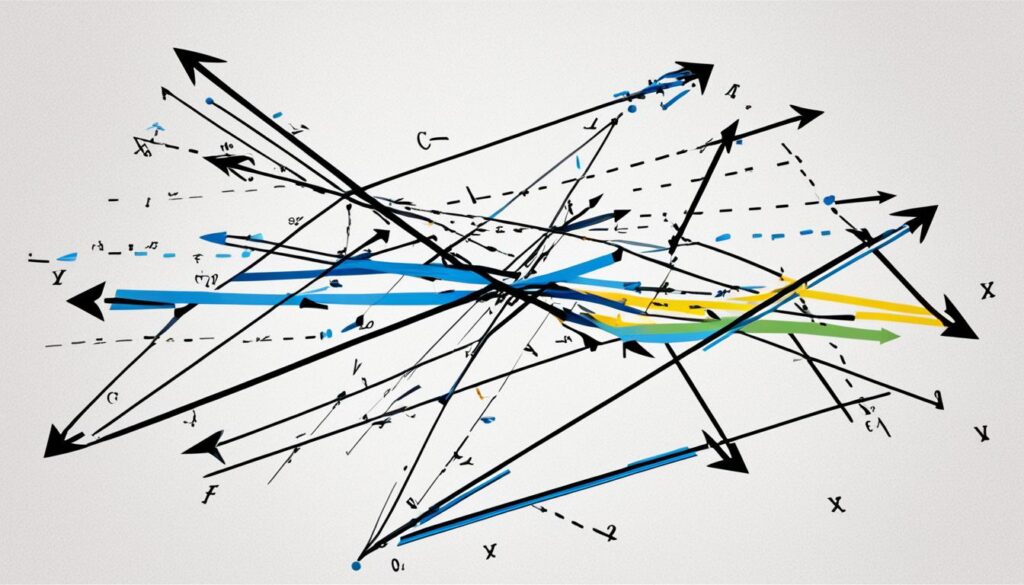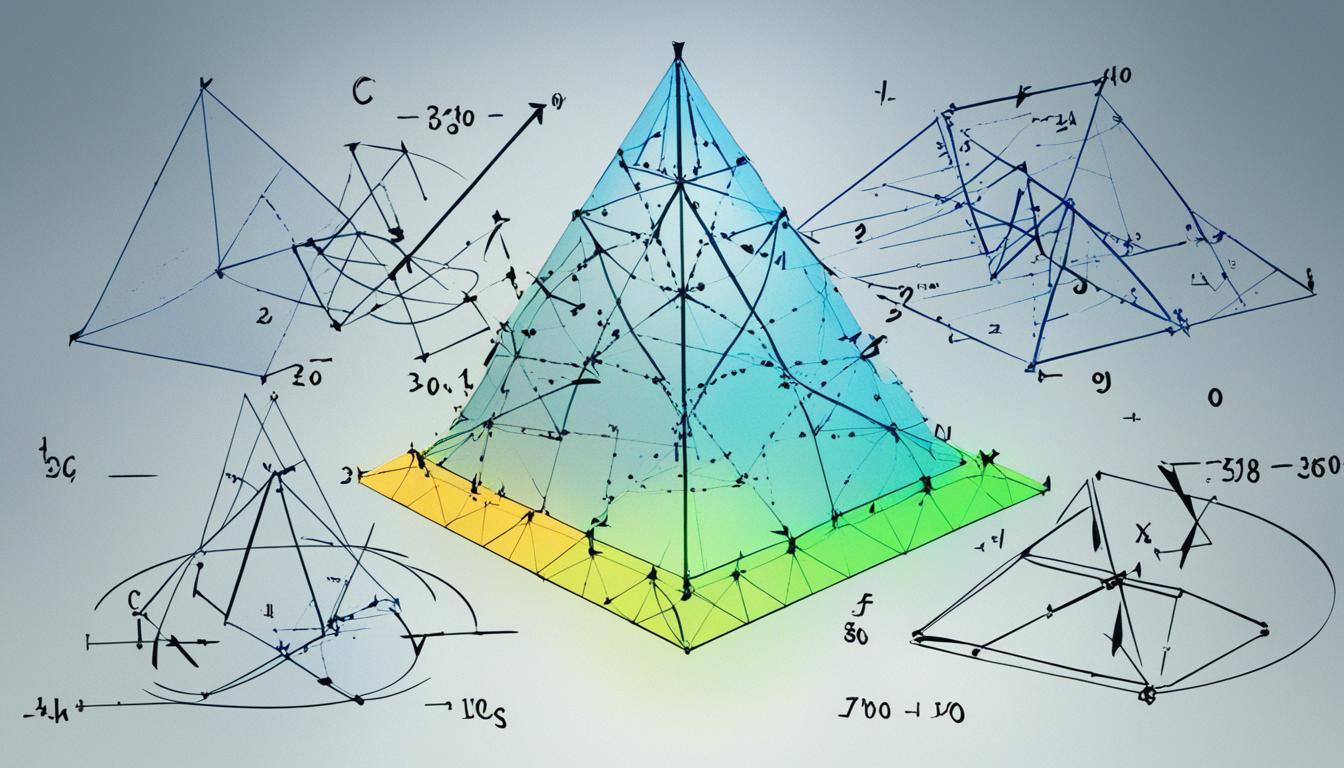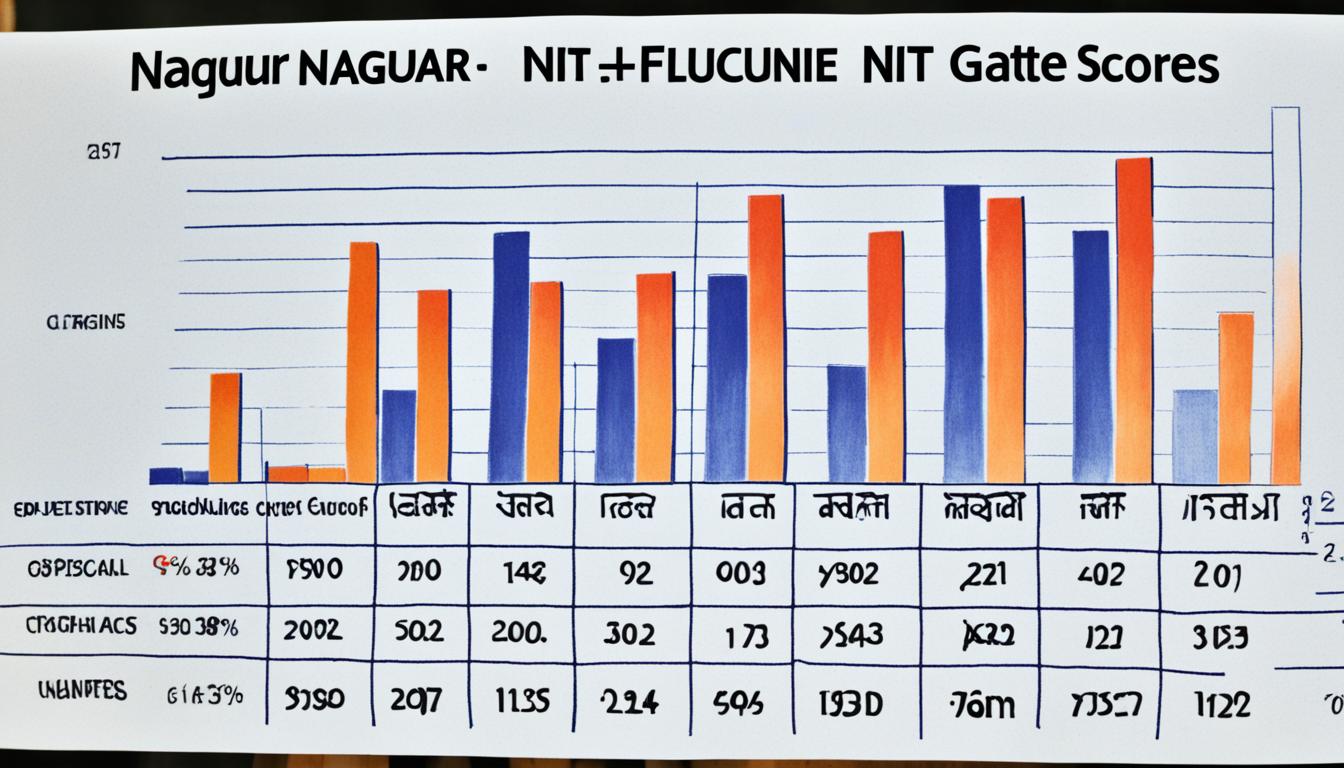In this section, we will explore the role of supplementary angles in kinematics equations. We will discuss how these angles are defined and their significance in motion analysis in physics. By understanding the relationship between supplementary angles and kinematics equations, we can gain a better understanding of how to analyze and describe motion.
Key Takeaways:
- Supplementary angles are angles that add up to 180 degrees.
- In kinematics, supplementary angles are used to analyze and describe motion.
- Understanding the relationship between supplementary angles and kinematics equations is essential for accurate motion analysis.
- Supplementary angles can be calculated using the formula 180 – angle.
- By applying supplementary angles in kinematics analysis, we can solve problems and interpret motion more effectively.
Understanding Angles in Kinematics
Before delving into the concept of supplementary angles in kinematics equations, it’s crucial to have a solid understanding of angles in kinematics. In the context of motion analysis, angles play a significant role in describing and interpreting various aspects of motion.
In kinematics, angles are defined as the geometric measures of the separation between two lines or planes. They are used to determine the direction and orientation of objects in motion, allowing us to analyze their paths and trajectories. By understanding angles in kinematics, we gain valuable insights into how objects move and interact in space.
Supplementary angles, in particular, are of great importance in kinematics. These angles refer to pairs of angles that sum up to 180 degrees. In the realm of motion analysis, supplementary angles are essential for understanding the relationship between different aspects of motion.
Now, let’s explore the basic kinematics equations that are used to describe motion. These equations provide mathematical relationships that enable us to quantify and analyze various physical quantities associated with motion, such as displacement, velocity, and acceleration.
The three fundamental kinematics equations for motion are:
- Equation 1: Displacement (Δx) = Initial Velocity (V0) × Time (t) + 0.5 × Acceleration (a) × Time (t)2
- Equation 2: Final Velocity (V) = Initial Velocity (V0) + Acceleration (a) × Time (t)
- Equation 3: Displacement (Δx) = (Initial Velocity (V0) + Final Velocity (V)) / 2 × Time (t)
These equations allow us to calculate and understand the relationships between displacement, velocity, acceleration, and time in a given motion scenario. By utilizing these equations, we can analyze and predict the behavior of objects in motion with accuracy.
| Displacement | Velocity | Acceleration | Time |
|---|---|---|---|
| Represents the change in position of an object. | Indicates the rate at which an object changes its position with respect to time. | Refers to the rate at which an object’s velocity changes over time. | Represents the duration of motion. |
By combining our understanding of angles in kinematics with the basic kinematics equations, we can accurately describe and analyze the motion of objects in various scenarios. This knowledge forms the foundation for further exploration of supplementary angles in kinematics equations, which we will delve into in the upcoming section.
The Significance of Supplementary Angles
In kinematics equations, supplementary angles play a crucial role in analyzing and describing motion accurately. By understanding and working with supplementary angles, we can gain deeper insights into the dynamics of objects in motion. Let’s explore the formula for calculating supplementary angles and examine some examples that demonstrate their application in motion analysis.
Formula for Calculating Supplementary Angles
Supplementary angles are a pair of angles that add up to 180 degrees. Mathematically, the formula for calculating supplementary angles is:
Supplementary Angles Formula: Angle 1 + Angle 2 = 180 degrees
This formula allows us to determine the measure of one angle when the measure of the other angle is known.
Examples of Supplementary Angles in Kinematics Equations
Let’s consider some examples to illustrate the practical application of supplementary angles in kinematics equations:
- Example 1: A car is moving along a curved path. The angle between the car’s velocity vector and the tangent to the curve at a given point is 60 degrees. What is the angle between the car’s acceleration vector and the tangent to the curve at the same point?
- Example 2: A projectile is launched at an angle of 30 degrees to the horizontal. What is the angle between the projectile’s velocity vector and the horizontal component of its motion?
In both examples, the angles involved are supplementary angles. By recognizing this relationship, we can use the supplementary angles formula to find the desired angles and gain a better understanding of the motion in these scenarios.
By leveraging the significance of supplementary angles in kinematics equations, we can accurately analyze and describe various aspects of motion. Whether it’s calculating angles between vectors, determining the orientation of motion, or solving complex motion problems, understanding supplementary angles enhances our proficiency in kinematics analysis.

Exploring Supplementary Angles in Trigonometry
Trigonometry is an essential tool for analyzing motion in kinematics, and understanding the relationship between supplementary angles and trigonometric functions is crucial. In this section, we will delve into the connection between supplementary angles and trigonometry, exploring how these angles can be used to analyze motion and solve problems.
Trigonometry provides us with a set of functions such as sine, cosine, and tangent that can be applied to calculate angles and distances. These functions are exceptionally useful when dealing with supplementary angles in kinematics.
“Trigonometric functions allow us to relate the angles and sides of triangles, giving us a deeper understanding of the motion being analyzed.”
Supplementary Angles and Trigonometric Functions
Supplementary angles are two angles that add up to 180 degrees. In the context of motion analysis, they can help us determine different aspects of an object’s motion, such as its displacement, velocity, and acceleration.
When working with trigonometric functions, it is important to note that they depend on the ratios of the sides of a right triangle. However, these functions can also be used in other scenarios, such as analyzing motion in kinematics. By connecting trigonometry and supplementary angles, we can gain powerful insights into the behavior of moving objects.
Let’s take a look at an example to illustrate how trigonometry and supplementary angles work together in kinematics:
- Consider an object moving in a straight line. We know the object’s displacement, but we want to determine its velocity.
- We can use the concept of supplementary angles to break down the displacement into horizontal and vertical components.
- By applying trigonometric functions to these components, we can calculate the object’s velocity in both the horizontal and vertical directions.
This example demonstrates the practical application of supplementary angles and trigonometry in kinematics. By utilizing these concepts, we can precisely analyze motion and solve complex problems related to displacement, velocity, and acceleration.
Supplementary Angles in Trigonometry Example
To further illustrate the connection between supplementary angles and trigonometry, let’s consider the following scenario:
“A car is traveling along a curved road, and we want to determine its speed. The angle between the road and the direction of the car’s motion is known.”
| Given | Unknown |
|---|---|
| The angle between the road and the direction of car’s motion | The car’s speed |
| The distance traveled by the car | |
| The time taken to travel the distance |
In this scenario, we can use supplementary angles and trigonometric functions to calculate the car’s speed. By understanding the relationship between angles and trigonometry, we can unlock valuable insights into the motion of objects.
The image above visually represents the concept of supplementary angles in trigonometry and how they can be applied to analyze motion in kinematics.
By exploring the connection between supplementary angles and trigonometry, we can enhance our understanding of motion analysis and improve our problem-solving skills in kinematics. Understanding how to apply these concepts enables us to accurately describe and analyze the motion of objects, providing valuable insights into the world of physics.
Derivation of Kinematics Equations
To fully understand the connection between supplementary angles and kinematics equations, it’s crucial to grasp how these equations are derived. In this section, we will provide a concise overview of the derivation of kinematics equations, shedding light on the fundamental principles and mathematical concepts that underpin these equations. This understanding will allow us to appreciate the role that supplementary angles play in the formulation of kinematics equations.
Kinematics equations are derived by analyzing the relationships between fundamental motion variables such as displacement, velocity, and acceleration. These equations serve as powerful tools for analyzing and predicting the motion of objects in various scenarios. By studying the derivation process, we can gain insights into how these equations incorporate supplementary angles and enable us to interpret motion accurately.
One of the key concepts in the derivation of kinematics equations is the understanding of motion as a result of constant acceleration. This concept allows us to simplify the analysis and establish relationships between displacement, velocity, acceleration, and time. By assuming constant acceleration, we can derive equations that effectively describe motion in a straightforward and applicable manner.
Let’s take a look at an example to illustrate the derivation process. Consider an object with an initial velocity v0, final velocity v, displacement s, acceleration a, and time t. By utilizing the constant acceleration assumption, we can derive the following equation:
s = v0t + 1/2at2
This equation, known as the displacement equation, demonstrates how the displacement of an object can be determined based on its initial velocity, time, and acceleration. By examining the derivation steps, we can recognize the role that supplementary angles play in manipulating the variables and ultimately formulating the equation.
By exploring the derivation of kinematics equations, we gain a deeper understanding of the principles and mathematical concepts that allow us to describe and analyze motion accurately. Supplementary angles are intricately connected to this derivation process, influencing the formulation of equations that enable us to interpret the intricacies of motion.
Continue reading to section 6 where we will apply the knowledge of supplementary angles and kinematics equations to real-world scenarios.
Section 6: Applying Supplementary Angles in Kinematics Analysis
Now that we have a firm understanding of the derivation of kinematics equations and the role played by supplementary angles, it’s time to put this knowledge into practice. In the next section, we will explore practical examples that demonstrate how supplementary angles are applied in kinematics analysis. By working through these examples, we can gain valuable insights into how to solve complex motion problems and further enhance our understanding of kinematics.
Applying Supplementary Angles in Kinematics Analysis
Now that we have a solid foundation in supplementary angles and kinematics equations, it’s time to apply this knowledge to real-world scenarios. In this section, we will provide practical examples of how supplementary angles are used in kinematics analysis. By working through these examples, we can develop a deeper understanding of how supplementary angles enhance our ability to analyze and interpret motion.
Example 1: Projectile Motion
Consider a projectile launched at an angle of 45 degrees to the horizontal. To analyze the motion, we can break down the initial velocity into its horizontal and vertical components using the trigonometric concept of supplementary angles. By calculating the supplementary angle of 45 degrees, which is 135 degrees, we can determine the horizontal and vertical motions separately using kinematics equations.
Example 2: Circular Motion
In circular motion, we often encounter angles that add up to supplementary angles. For instance, consider an object moving in a horizontal circle with a speed of 10 m/s. To find the centripetal acceleration, we need to calculate the angle between the object’s velocity vector and the centripetal acceleration vector. By identifying the supplementary angle to the given angle, we can use kinematics equations to determine the magnitude and direction of the centripetal acceleration.
Example 3: Angular Velocity
When analyzing rotational motion, supplementary angles come into play when calculating angular velocity. For instance, suppose a wheel completes one revolution in 4 seconds. By determining the supplementary angle to the given angle of 360 degrees, we can find the angular velocity of the wheel using the kinematics equation for angular displacement over time. This allows us to quantify the rotational motion and understand the relationship between angular velocity and time.
By examining these examples, we can see how supplementary angles play a crucial role in kinematics analysis. Whether in projectile motion, circular motion, or rotational motion, understanding and applying supplementary angles allow us to break down complex motions into simpler components and utilize kinematics equations effectively. This enables us to accurately analyze and interpret various motion scenarios, aiding in the study of physics and practical problem-solving.
With a firm grasp of the concept of supplementary angles and its application in kinematics analysis, we can now move forward to explore the connection between supplementary angles and trigonometry in the next section.
Conclusion
In conclusion, the understanding of supplementary angles in kinematics equations is crucial for accurately describing and analyzing various aspects of motion. By recognizing the relationship between supplementary angles and kinematics equations, we gain valuable insights into the principles of motion analysis in physics.
Through our exploration of supplementary angles and their significance, we have learned how to identify and work with these angles effectively. This knowledge empowers us to apply kinematics equations confidently in real-world scenarios, enhancing our problem-solving skills in the field of kinematics.
By delving into the derivation of kinematics equations and exploring the connection between supplementary angles and trigonometry, we have developed a solid foundation for motion analysis. Our ability to compute supplementary angles accurately allows us to decipher complex motion patterns and uncover valuable insights about physical systems.
In summary, the study of supplementary angles provides valuable tools and techniques for analyzing motion. By leveraging the relationship between supplementary angles and kinematics equations, we can unlock a deeper understanding of the dynamic world around us.
FAQ
What are supplementary angles in kinematics equations?
Supplementary angles in kinematics equations refer to a pair of angles that add up to 180 degrees. These angles play a significant role in motion analysis in physics, allowing us to analyze and describe the relationship between different aspects of motion accurately.
How are angles defined in kinematics?
In kinematics, angles are defined as the measure of the rotation between two lines or reference points. They are crucial in determining the direction and orientation of motion. By understanding angles in kinematics, we can accurately describe the path and trajectory of moving objects.
What is the significance of supplementary angles in kinematics equations?
Supplementary angles have significant significance in kinematics equations as they help us calculate and analyze various aspects of motion. By understanding how to identify and work with supplementary angles, we can accurately describe the relationship between different variables, such as displacement, velocity, and acceleration.
How are supplementary angles calculated in kinematics analysis?
To calculate supplementary angles in kinematics analysis, we can use the formula: angle + supplementary angle = 180 degrees. By rearranging the equation, we can solve for the supplementary angle given the measure of the initial angle.
Can you provide examples of supplementary angles in kinematics equations?
Certainly! Here’s an example: if we have an angle measuring 60 degrees, its supplementary angle would be 180 degrees – 60 degrees, which equals 120 degrees. In kinematics analysis, we can use these supplementary angles to determine various properties of motion, such as the direction of an object’s velocity or the angle of an object’s acceleration.
How does trigonometry relate to supplementary angles in kinematics?
Trigonometry plays a crucial role in analyzing supplementary angles in kinematics. Trigonometric functions, such as sine, cosine, and tangent, can be used to determine the relationship between different angles and sides of a triangle. By applying trigonometry to supplementary angles, we can calculate various properties related to motion, such as the height of a projectile or the angle of launch.
How are kinematics equations derived?
Kinematics equations are derived using mathematical principles and concepts, such as calculus and vector analysis. These equations are based on the fundamental relationships between displacement, velocity, acceleration, and time. By understanding the derivation of kinematics equations, we can better appreciate the role of supplementary angles in formulating these equations and analyzing motion.
How can I apply supplementary angles in kinematics analysis?
To apply supplementary angles in kinematics analysis, you can start by identifying the angles involved in a given motion scenario. From there, you can use trigonometry and kinematics equations to calculate angles of launch, angles of elevation, or angles of deflection. By understanding how to work with supplementary angles, you can enhance your ability to accurately describe and analyze real-world motion situations.










